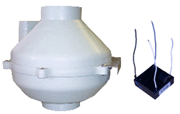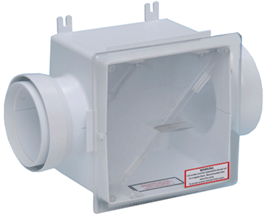How do I determine if I will need a dryer booster fan?
The Problem:
In a majority of the residential clothes dryer installations, a short dryer duct length is not always possible.
With excessive duct runs with many turns, the static pressure drop in the duct will be too high and reduce the amount of air that will be extracted from the dryer. The results are prolonged drying times, higher energy usage/costs, and excessive wear and tear on the dryer.
Typical residential dryers are rated at around 160 CFM. This rating is normally measured with no duct and no load in the dryer. Therefore, a residential booster fan is generally needed in order to maintain a minimum airflow of 100 cfm. A secondary lint trap is recommended in order to have lint gather up in your duct work.
Dryer boosting is typically required when the duct length exceeds the following:
Maximum duct length with
0 bends = 25'
1 bend = 20'
2 bends = 15'
3 bends = 10' |
 |
The Solution:
The solution is to install a dryer booster fan in-line in the existing duct, preferably 15 feet or more from the dryer. A current sensor is used to sense if the dryer is turned on. If the sensor senses current to the dryer, the fan is started. Once the dryer stops, a timer is activated and the fan will continue to evacuate moisture and lint from the duct for seven minutes. Dryer boosting is neccessary in a majority of the clothes dryer installations nowadays.
Lint build up and solutions:
Did you know that an improperly maintained dryer could cause a fire? Lint build up in the dryer and its exhaust duct can cause many problems. It can block the flow of air, preventing your clothes from drying properly. It can create excessive heat build up. It can even result in a fire in some models of dryers.
Some dryer booster manufacturers are showing tailored demonstration videos of massive amounts of lint being fed through a dryer booster fan. This is absolutely not a real life scenario and that amount of lint is never going to be present in your system. So their solution to this non-existing problem is to use a material handling fan that is efficient in dispersing materia in the airstream instead of have optimal air performance which is the most important in reducing drying time.
The easy solution to avoid any lint buildup in your ductwork is to add a secondary lint trap placed inline (before) your dryer booster fan. This will catch all of the lint that escapes from your dryers internal built in lint trap and no lint will be passing through the dryer booster fan.
Fan Recommendation:
When selecting a dryer boster fan, you will find that there are several options available. The main criterias to look at is airflow performance, reliability and cost.
There are several dryer booster products out in the marketplace, but the most cost efficient high-end product that we recommend is one that is sold by www.directfans.com. It is very cost efficient and has great quality. Their system is straight forward easy and reliable. |




